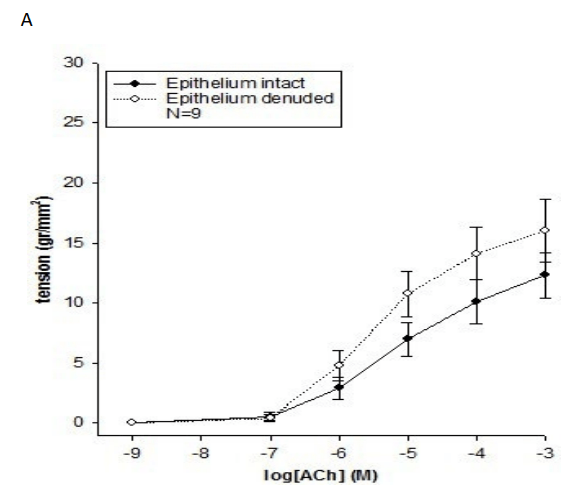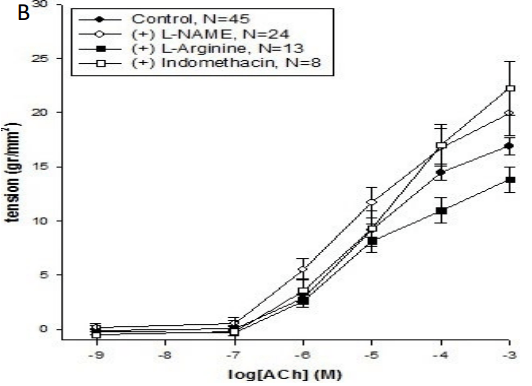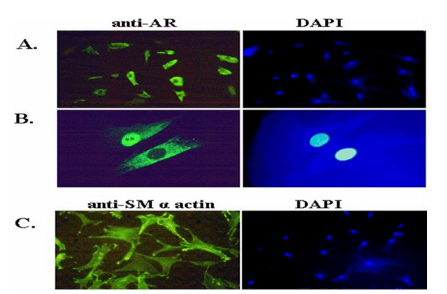1. Ricciardolo FL. Multiple roles of nitric oxide in the airways. Thorax. 2003; 58(2): 175-182. doi: 10.1136/thorax.58.2.175
2. Holgate ST. The airway epithelium is central to the pathogenesis of asthma. Allergol Int. 2008; 57(1): 1-10. doi: 10.2332/allergolint.R-07-154
3. Knight DA, Stewart GA, Thompson PJ. Histamine tachyphylaxis in human airway smooth muscle. The role of H2-receptors and the bronchial epithelium. Am Rev Respir Dis. 1992; 146(1): 137-140. doi: 10.1164/ajrccm/146.1.137
4. Knight DA, Holgate ST. The airway epithelium: structural and functional properties in health and disease. Respirology 2003; 8(4): 432-446. doi: 10.1046/j.1440-1843.2003.00493.x
5. de Marco R, Locatelli F, Sunyer J, Burney P. Differences in incidence of reported asthma related to age in men and women. A retrospective analysis of the data of the European Respiratory Health Survey. Am J Respir Crit Care Med. 2000; 162(1): 68-74. doi: 10.1164/ajrccm.162.1.9907008
6. Papagianni M, Hatziefthimiou A, Chachami G, Gourgoulianis K, Molyvdas PA, Paraskeva E. Insulin causes a transient induction of proliferation via activation of the PI3-kinase pathway in airway smooth muscle cells. Exp Clin Endocrinol Diabetes. 2007; 115(2): 118-123. doi: 10.1055/s-2007-967094
7. Gosens R, Nelemans SA, Hiemstra M, Grootte Bromhaar MM, Meurs H, Zaagsma J. Insulin induces a hypercontractile airway smooth muscle phenotype. Eur J Pharmacol. 2003; 481(1): 125-131. doi: 10.1016/j.ejphar.2003.08.081
8. Dekkers BG, Schaafsma D, Tran T, Zaagsma J, Meurs H. Insulin-induced laminin expression promotes a hypercontractile airway smooth muscle phenotype. Am J Respir Cell Mol Biol. 2009; 41(4): 494-504. doi: 10.1165/rcmb.2008-0251OC
9. Schaafsma D, McNeill KD, Stelmack GL, et al. Insulin increases the expression of contractile phenotypic markers in airway smooth muscle. Am J Physiol Cell Physiol. 2007; 293(1): C429- C439. doi: 10.1152/ajpcell.00502.2006
10. Schaafsma D, Gosens R, Ris JM, Zaagsma J, Meurs H, Nelemans SA. Insulin induces airway smooth muscle contraction. Br J Pharmacol. 2007; 150(2): 136-142. doi: 10.1038/sj.bjp.0706985
11. Numata T, Araya J, Fujii S, et al. Insulin-dependent phosphatidylinositol 3-kinase/Akt and ERK signaling pathways inhibit TLR3-mediated human bronchial epithelial cell apoptosis. J Immunol. 2011; 187(1): 510-519. doi: 10.4049/jimmunol.1004218
12. Romberger DJ, Pladsen P, Claassen L, Yoshida M, Beckmann JD, Rennard SI. Insulin modulation of bronchial epithelial cell fibronectin in vitro. Am J Physiol. 1995; 268(2 Pt 1): L230-L238. doi: 10.1152/ajplung.1995.268.2.l230
13. Papayianni M, Gourgoulianis KI, Molyvdas PA. Insulin NO-dependent action on airways smooth muscles. Nitric Oxide. 2001; 5(1): 72-76. doi: 10.1006/niox.2000.0317
14. Sadeghi-Hashjin G, Folkerts G, Henricks PA, et al. Induction of guinea pig airway hyperresponsiveness by inactivation of guanylate cyclase. Eur J Pharmacol. 1996; 302(1-3): 109-115. doi: 10.1016/0014-2999(96)00081-7
15. Rada B, Boudreau HE, Park JJ, Leto TL. Histamine stimu-lates hydrogen peroxide production by bronchial epithelial cells via histamine H1 receptor and dual oxidase. Am J Respir Cell Mol Biol. 2014; 50(1): 125-134. doi: 10.1165/rcmb.2013-0254OC
16. Huang HT, Guo JJ, Huang YH, Fu YS. Histamine-induced changes in rat tracheal goblet cell mucin store and mucosal edema. Histochem Cell Biol. 2013; 139(5): 717-726. doi: 10.1007/s00418-012-1060-y
17. Spicuzza L, Basile L, Belvisi MG, et al. The protective role of epithelium-derived nitric oxide in isolated bovine trachea. Pulm Pharmacol Ther. 2002; 15(4): 357-362. doi: 10.1006/pupt.2002.0377
18. Gourgoulianis K, Iliodromitis Z, Hatziefthimiou A, Molyvdas PA. Epithelium-dependent regulation of airways smooth muscle function. A histamine-nitric oxide pathway. Mediators Inflamm. 1998; 7(6): 409-411. doi: http://dx.doi.org/10.1248/bpb.33.58
19. Sun P, Jin X, Koyama T, Li S, Kitamura Y, Kawasaki H. R-(-)-alpha-methylhistamine, a histamine H3 receptor agonist, induces endothelium-dependent vasodilation in rat mesenteric resistance arteries. Biol Pharm Bull. 2010; 33(1): 58-63. doi: http://dx.doi.org/10.1248/bpb.33.58
20. Thors B, Halldórsson H, Thorgeirsson G. eNOS activation mediated by AMPK after stimulation of endothelial cells with histamine or thrombin is dependent on LKB1. Biochim Biophys Acta. 2011; 1813(2): 322-331. doi: 10.1016/j.bbamcr.2010.12.001
21. Gourgoulianis KI, Chatziparasidis G, Chatziefthimiou A, Molyvdas PA. Magnesium as a relaxing factor of airway smooth muscles. J Aerosol Med. 2001; 14(3): 301-307. doi: 10.1089/089426801316970259
22. Kitsiopoulou E, Hatziefthimiou AA, Gourgoulianis KI, Molyvdas PA. Resting tension affects eNOS activity in a calcium-dependent way in airways. Mediators Inflamm. 2007; 24174. doi: 10.1155/2007/24174
23. Proskocil BJ, Sekhon HS, Jia Y et al. Acetylcholine is an autocrine or paracrine hormone synthesized and secreted by airway bronchial epithelial cells. Endocrinology. 2004; 145(5): 2498-2506. doi: http://dx.doi.org/10.1210/en.2003-1728
24. Koyama S, Rennard SI, Robbins RA. Acetylcholine stimulates bronchial epithelial cells to release neutrophil and monocyte chemotactic activity. Am J Physiol. 1992; 262 (4 Pt 1): L466-L471. doi: 10.1152/ajplung.1992.262.4.L466
25. Koyama S, Sato E, Nomura H, Kubo K, Nagai S, Izumi T. Acetylcholine and substance P stimulate bronchial epithelial cells to release eosinophil chemotactic activity. J Appl Physiol (1985). 1998; 84(5): 1528-1534. doi: 10.1152/jappl.1998.84.5.1528
26. Profita M, Bonanno A, Siena L, et al. Acetylcholine mediates the release of IL-8 in human bronchial epithelial cells by a NFkB/ERK-dependent mechanism Eur J Pharmacol. 2008; 582(1-3): 145-153. doi: 10.1016/j.ejphar.2007.12.029
27. Barnes PJ. Muscarinic receptors subtypes in airways. Eur Respir J. 1993; 6(3): 328-331. doi: 10.1016/0024-3205(93)90310-y
28. Stamatiou R, Paraskeva E, Vasilaki A, Mylonis I, Molyvdas PA, Gourgoulianis K, Hatziefthimiou A. Long-term exposure to muscarinic agonists decreases expression of contractile proteins and responsiveness of rabbit tracheal smooth muscle cells. BMC Pulm Med. 2014;14: 39.
29. Gosens R, Zaagsma J, Meurs H, Halayko AJ. Muscarinic receptor signaling in the pathophysiology of asthma and COPD. Respir Res. 2006; 7: e73. doi: 10.1186/1465-9921-7-73
30. Folkerts G, Kloek J, Geppetti P, Van der Linde HJ, Nijkamp FP. Factors that determine acetylcholine responsiveness of guinea pig tracheal tubes. Eur J Pharmacol. 2001; 420(2-3): 151-157. doi: 10.1016/S0014-2999(01)01016-0
31. Spicuzza L, Basile L, Belvisi MG, Bellofiore S, Matera MG, Cazzola M, Di Maria GU. The protective role of epithelium-derived nitric oxide in isolated bovine trachea. Pulm Pharmacol Ther. 2002; 15(4): 357-362. doi: 10.1006/pupt.2002.0377
32. Sparrow MP, Mitchell HW. Contraction of smooth muscle of pig airway tissues from before birth to maturity. J Appl Physiol (1985). 1990; 68(2): 468-477. doi: 10.1152/jappl.1990.68.2.468
33. Chitano P, Cox CM, Murphy TM. Relaxation of guinea pig trachealis during electrical field stimulation increases with age. J Appl Physiol (1985). 2002; 92(5): 1835-1842. doi: 10.1152/japplphysiol.00688.2001
34. Grunstein MM, Rosenberg SM, Schramm CM, Pawlowski NA. Mechanisms of action of endothelin 1 in maturing rabbit airway smooth muscle. Am J Physiol. 1991; 260(6 Pt 1): L434-443. doi: 10.1152/ajplung.1991.260.6.l434
35. Deoras KS, Wolfson MR, Searls RL, Hifler SR, Shaffer TH. Developmental changes in tracheal structure. Pediatr Res. 1991; 30(2): 170-175.doi: 10.1203/00006450-199108000-00010
36. Ramchandani R, Shen X, Elmsley CL, Ambrosius WT, Gunst SJ, Tepper RS. Differences in airway structure in immature and mature rabbits. J Appl Physiol (1985). 2000; 89(4): 1310-1316. doi: 10.1152/jappl.2000.89.4.1310
37. Colasurdo GN, Loader JE, Graves JP, Larsen GL. Maturation of nonadrenergic noncholinergic inhibitory system in normal and allergen-sensitized rabbits. Am J Physiol. 1994; 267(6 Pt 1): L739-L744. doi: 10.1152/ajplung.1994.267.6.l739
38. Murphy TM, Mitchell RW, Phillips IJ, Leff AR. Ontogenic expression of acetylcholinesterase activity in trachealis of young swine. Am J Physiol. 1991; 261(4 Pt 1): L322-L326. doi: 10.1152/ajplung.1991.261.4.L322
39. Jakupaj M, Martin RG, Dreshaj IA, Potter CF, Haxhiu MA, Ernsberger P. Role of endogenous NO in modulating airway contraction mediated by muscarinic receptors during development. Am J Physiol. 1997; 273(3 Pt 1): L531-L536. doi: 10.1152/ajplung.1997.273.3.l531
40. Sherman TS, Chen Z, Yuahanna IS, Lau KS, Margraf LR, Shaul PW. Nitric oxide synthase isoform expression in the developing lung epithelium. Am J Physiol.1999; 276(2 Pt 1): L383-L390. doi: 10.1152/ajplung.1999.276.2.l383
41. Kouloumenta V, Hatziefthimiou A, Paraskeva E, Gourgoulianis K, Molyvdas PA. Sexual dimorphism in airway responsiveness to sex hormones in rabbits Am J Physiol Lung Cell Mol Physiol. 2007; 293(2): L516. doi: 10.1152/ajplung.00192.2007
42. Dahlman-Wright K, Cavailles V, Fuqua SA, et al. International Union of Pharmacology. LXIV. Estrogen receptors. Pharmacol Rev. 2006; 58(4): 773-781. doi: 10.1124/pr.58.4.8
43. Hibbert M, Lannigan A, Raven J, Landau L, Phelan P. Gender differences in lung growth. Pediatr Pulmonol. 1995; 19(2): 129-134. doi: 10.1002/ppul.1950190208
44. Torday JS, Nielsen HC, Fencl Mde M, Avery ME. Sex differences in fetal lung maturation. Am Rev Respir Dis. 1981; 123(2): 205-208. doi: 10.1164/arrd.1981.123.2.205
45. Osman M. Therapeutic implications of sex differences in asthma and atopy. Arch Dis Child. 2003; 88(7): 587-590. doi: 10.1136/adc.88.7.587
46. Levesque BM, Vosatka RJ, Nielsen HC. Dihydrotestosterone stimulates branching morphogenesis, cell proliferation and programmed cell death in mouse embryonic lung explants. Pediatr Res. 2000; 47(4 Pt 1): 481-491.
47. Wilson CM, McPhaul MJ. A and B forms of androgen receptor are expressed in a variety of human tissues. Mol Cell Endocrinol. 1996; 120(1): 51-57. doi: 10.1016/0303-7207(96)03819-1
48. Dashtaki R, Whorton AR, Murphy TM, Chitano P, Reed W, Kennedy TP. Dehydroepiandrosterone and analogs inhibit DNA binding of AP-1 and airway smooth muscle proliferation. J Pharmacol Exp Ther. 1998; 285(2): 876-883. doi: 10.1203/00006450-200004000-00012
49. Stamatiou R, Paraskeva E, Papagianni M, Molyvdas PA, Hatziefthimiou A. The mitogenic effect of testosterone and 17β-estradiol on airway smooth muscle cells. Steroids. 2011; 76(4): 400-408. doi: 10.1016/j.steroids.2010.12.010
50. Pang JJ, Xu XB, Li HF, Zhang XY, Zheng TZ, Qu SY. Inhibition of beta-estradiol on trachea smooth muscle contraction in vitro and in vivo. Acta Pharmacol Sin. 2002; 23(3): 273-277.
51. Card JW, Voltz JW, Ferguson CD, et al. Male sex hormones promote vagally mediated reflex airway responsiveness to cholinergic stimulation. Am J Physiol Lung Cell Mol Physiol. 2007; 292(4): L908-L914. doi: 10.1152/ajplung.00407.2006
52. Kouloumenta V, Hatziefthimiou A, Paraskeva E, Gourgoulianis K, Molyvdas PA. Non-genomic effect of testosterone on airway smooth muscle. Br J Pharmacol. 2006; 149(8): 1083-1091. doi: 10.1038/sj.bjp.0706936
53. Bordallo J, de Boto MJ, Meana C, et al. Modulatory role of endogenous androgens on airway smooth muscle tone in isolated guinea-pig and bovine trachea; involvement of β2-adrenoceptors, the polyamine system and external calcium. Eur J Pharmacol. 2008; 601(1-3): 154-162. doi: 10.1016/j.ejphar.2008.10.039
54. Suárez L, Pipa M, Granda J, et al. Sex hormones modulate salbutamol-elicited long-term relaxation in isolated bovine tracheal strips. Pharmacology. 2011; 87(5-6): 249-256. doi: 10.1159/000324315
55. Ma X, Li W, Stephens NL. Detection of two clusters of mechanical properties of smooth muscle along the airway tree. J Appl Physiol (1985). 1996; 80(3): 857-861. doi: 10.1152/jappl.1996.80.3.857
56. Bai Y, Zhang M, Sanderson MJ. Contractility and Ca2+ signaling of smooth muscle cells in different generations of mouse airways. Am J Respir Cell Mol Biol. 2007; 36(1): 122-130. doi: 10.1165/rcmb.2006-0036OC
57. McKay KO, Wiggs BR, Paré PD, Kamm RD. Zero-stress state of intra- and extraparenchymal airways from human, pig, rabbit, and sheep lung. J Appl Physiol (1985). 2002; 92(3): 1261-1266. doi: 10.1152/japplphysiol.00131.2001
58. Goroumaru-Shinkai M, Yamamoto R, Funayama N, Takayanagi I. Regional differences of the contractile responses to acetylcholine and neurokinin A in rabbit airway: heterogeneous distribution of the metabolic enzymes. Gen Pharmacol. 1992; 23(6): 1057-1061. doi: 10.1016/0306-3623(92)90286-S
59. Maize DF, Fedan JS, Dey RD. Characterization of neural control and contractile function in airway smooth muscle of the ferret. Pulm Pharmacol Ther. 1998; 11(1): 57-64. doi: 10.1006/pupt.1998.0117
60. Boucher RC Jr, Bromberg PA, Gatzy JT. Airway transepithelial electric potential in vivo: species and regional differences. J Appl Physiol Respir Environ Exerc Physiol. 1980; 48(l): 169-176. doi: 10.1152/jappl.1980.48.1.169
61. Mariassy AT, Plopper CG. Tracheobronchial epithelium of the sheep: I. Quantitative light-microscopic study of epithelial cell abundance, and distribution. Anat Rec. 1983; 205(3): 263-275. doi: 10.1002/ar.1092050304
62. Ballard ST, Schepens SM, Falcone JC, Meininger GA, Taylor AE. Regional bioelectric properties of porcine airway epithelium. J Appl Physiol (1985). 1992; 73(5): 2021-2027. doi: 10.1152/jappl.1992.73.5.2021
63. Al-Bazzaz FJ, Hafez N, Tyagi S, et al. Detection of Cl–HCO3- and Na+-H+ exchangers in human airways epithelium. JOP. 2001; 2(4 Suppl): 285-290.
64. Hay DW, Raeburn D, Fedan JS. Regional differences in reactivity and in the influence of the epithelium on canine intrapulmonary bronchial smooth muscle responsiveness. Eur J Pharmacol. 1987; 141(3): 363-370. doi: 10.1016/0014-2999(87)90553-x
65. Hatziefthimiou A, Kiritsi M, Kiropoulou C, Vasilaki A, Sakellaridis N, Molyvdas PA. Regional differences in the modulatory role of the epithelium in sheep airway. Clin Exp Pharmacol Physiol. 2009; 36(7): 668-674. doi: 10.1111/j.1440-1681.2008.05131.x
66.Pratusevich VR, Seow CY, Ford LE. Plasticity in canine airway smooth muscle. J Gen Physiol. 1995; 105(1): 73-94. doi: 10.1085%2Fjgp.105.1.73
67. Kuo KH, Herrera AM, Wang L, Paré PD, Ford LE, Stephens NL, Seow CY. Structure-function correlation in airway smooth muscle adapted to different lengths. Am J Physiol Cell Physiol. 2003; 285(2): C384-C390. doi: 10.1152/ajpcell.00095.2003
68. Hatziefthimiou AA, Karetsi E, Pratzoudis E, Gourgoulianis KI, Molyvdas PA. Resting tension effect on airway smooth muscle: the involvement of epithelium. Respir Physiol Neurobiol. 2005; 145(2-3): 201-208. doi: 10.1016/j.resp.2004.06.004
69. Mehta D, Wu MF, Gunst SJ. Role of contractile protein activation in the lenght-dependent modulation of tracheal smooth muscle force. Am J Physiol. 1996; 270(1 Pt 1): C243-C252. doi: 10.1152/ajpcell.1996.270.1.c243
70. Gilbert EK, Weaver BA, Rembold CM. Depolarisation decreaces the [Ca2+]i sensitivity of myocin light-chain kinase in arterial smooth muscle: comparison of aequorin and fura 2 [Ca2+]i estimates. FASEB J. 1991; 5(11): 2593-2599. doi: 10.1096/fasebj.5.11.1868983
71. Mandal TK. Inhaled insulin for diabetes mellitus. Am J Health Syst Pharm. 2005; 62(13): 1359-1364. doi: 10.1002/14651858.CD003890
72. Szczeklik A, Pieton R, Sieradzki J. Alternation in both insulin release and its hypoglycemic effects in atopic bronchial asthma. J Allergy Clin Immunol. 1980; 66(5): 424-427. doi: 10.1016/0091-6749(80)90123-2
73. Gosens R, Zaagsma J, Meurs H, Halayko AJ. Muscarinic receptor signaling in the pathophysiology of asthma and COPD. Respir Res. 2006; 7: 73. doi: 10.1186%2F1465-9921-7-73
74. Sherman TS, Chen Z, Yuahanna IS, Lau KS, Margraf LR, Shaul PW. Nitric oxide synthase isoform expression in the developing lung epithelium. Am J Physiol. 1999; 276 (2 Pt 1): L383-L390. doi: 10.1152/ajplung.1999.276.2.l383
75. Mhanna MJ, Dreshaj IA, Haxhiu MA, Martin RJ. Mechanism for subsance induced relaxation of precontracted airway smooth muscle during development. Am J Physiol. 1999; 276 (1 Pt 1): L51-L56. doi: 10.1203/00006450-199804001-01992
76. Semple PD, Beastall GH, Watson WS, Hume R. Serum testosterone depression associated with hypoxia in respiratory failure. Clin Sci (Lond). 1980; 58(1): 105-106. doi: 10.1042/cs0580105
77. Leifke E, Friemert M, Heilmann M, Puvogel N, Smaczny C, von zur Muhlen A, Brabant G. Sex steroids and body composition in men with cystic fibrosis. Eur J Endocrinol. 2003; 148(5): 551-557. doi: 10.1530/eje.0.1480551
78. Semple PD, Beastall GH, Brown TM, Stirling KW, Mills RJ, Watson WS. Sex hormone suppression and sexual impotence in hypoxic pulmonary fibrosis. Thorax. 1984; 39(1): 46-51. doi: 10.1136/thx.39.1.46
79. Creutzberg EC, Casaburi R. Endocrinological disturbances in chronic obstructive pulmonary disease. Eur Respir J Suppl. 2003; 46: 76s-80s. doi: 10.1183/09031936.03.00004610
80. Kapsali T, Permutt S, Laube B, Scichilone N, Togias A. Potent bronchoprotective effect of deep inspiration and its absence in asthma. J Appl Physiol (1985). 2000; 89(2): 711-720. doi: 10.1152/jappl.2000.89.2.711
81. Scichilone N, Kapsali T, Permutt S, Togias A. Deep inspiration-induced bronchoprotection is stronger than bronchodilation. Am J Respir Crit Care Med. 2000; 162(3 Pt 1): 910-916. doi: 10.1164/ajrccm.162.3.9907048
82. Scichilone N, Permutt S, Togias A. The lack of the bronchoprotective and not the bronchodilatory ability of deep inspiration is associated with airway hyperresponsiveness. Am J Respir Crit Care Med. 2001; 163(2): 413-419. doi: 10.1164/ajrccm.163.2.2003119
83. Scichilone N, Marchese R, Catalano F, Vignola AM, Togias A, Bellia V. Bronchodilatory effect of deep inspiration is absent in subjects with mild COPD. Chest. 2004; 125(6): 2029-2035. doi: 10.1378/chest.125.6.2029








